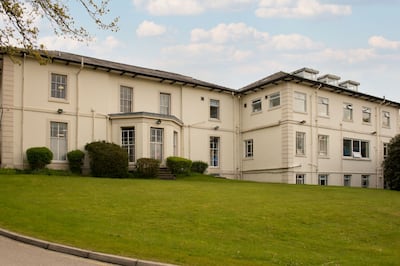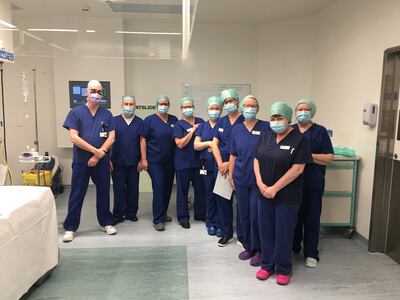Trauma and orthopaedic surgeon Fizan Younis saw first hand during the pandemic how a small hospital could expand at speed using flat-pack extensions.
“It just seemed to appear out of nowhere in just a few months,” Mr Younis recalled of the new theatre that was connected to The Beardwood Hospital in Blackburn from the car park. “The theatres literally drop down on cranes and are set up really quickly.”
Across the UK, hospitals like The Beardwood are developing innovative ways to grow and take in more patients, but a new report raised fears the NHS – which began the trend – may soon lag behind without better government funding.
Mr Younis told The National how his hospital in the north of England grew swiftly so that it could treat more cancer patients.
Housed in a former convent, it had started taking NHS patients whose care was disrupted by the pandemic.
“We’ve got a population of 600,000 people within our catchment, served by two NHS hospitals, in Blackburn and Burnley. During the pandemic, [the hospitals] could still provide some routine operations to some extent, but most of them were stopped,” said Mr Younis.
But the hospital had only two operating theatres on its premises, which could not cover the fallout. “While that was useful to absorb cancer work and smaller procedures, you could not get the scale needed to treat the 600,000 people we were serving,” he said.
To make more space, they used modular operating theatres – prefabricated units which can be connected to an existing building. They are often used in emergency scenarios, such as earthquakes, owing to the speed and flexibility with which they can be built.
A treatment room, used for injections and X-rays, was also temporarily turned into a theatre. Each additional theatre allowed the Beardwood to treat an average of seven cases a day, and sometimes up to 15. “It meant they could build up their reserves very quickly,” Mr Younis recalled.
Modular hospital units which are fabricated off-site are part of the government’s pledge to build 40 new hospitals with modern and sustainable construction methods by 2030.
These units range from operating theatres to imaging suites and can be designed to any specification. The parts are made in a factory and then assembled at the hospital, at a much quicker pace than traditional building methods.

But a July report by the National Audit Office found that the government’s New Hospitals Programme, which was created in 2020 to build this extra capacity was behind schedule.
“By the definition the government used in 2020, it will not now deliver 40 new hospitals by 2030,” it said, citing the delays in a switch to flat-pack assembled facilities as a prime reason.
Rishi Sunak, the Prime Minister, rebuffed the warning and said the plan to build the hospitals was one of the “many things we're doing” to improve health care.
Construction on modular hospitals was due to begin in 2025. But the standard design for these, named Hospital 2.0 and due by the end of 2023, has been postponed until May next year.
Hospital 2.0 would see a standardised “kit of parts” for new hospitals, with units prefabricated off-site. The NHS estimated that its fourth cohort of new hospitals – planned for construction after 2025 – would be built 25 per cent cheaper and 20 per cent faster compared to traditional methods.
But a version of the design seen by auditors may result in the hospitals being too small due to budget constraints, the report said. Other risks included a shortage of contractors and suppliers – which were aggravated by the delays to the design.

NHS hospitals accelerated their use of modular theatres during the pandemic when large parts of their existing facilities were cordoned off to treat Covid-19 patients. The private sector soon followed, and the Beardwood became among the first private hospitals to use the technology.
Today, Beardwood’s modular theatre is used to treat private patients and the growing backlog of NHS patients seeking planned care for joint surgeries.
It is one of the many ways in which hospitals are adapting existing spaces to accommodate a growing patient population. “A lot of the old hospitals are Victorian and Edwardian buildings, and some are listed. They’re quite difficult to try and add to,” said Mr Younis.
One emerging trend has been converting car showrooms, which have industrial water and industrial gases that are also used by hospitals, into imaging suites with a “minimal” amount of work, according to a representative from Circle Health Group, which operates the Beardwood.
The healthcare company's Ross Hall Clinic Braehead in Scotland saw former offices being converted into a hospital within nine months in 2021. It would have taken years to build an entirely new facility of the same size.
Existing rooms in private hospitals, which are underused, also have the potential to be converted into additional facilities.
UK hospitals are “crying out” for more state-of-the-art operating theatres, said Mr Younis. But traditional methods of expansion were too slow, meaning the system cannot treat the UK's growing backlog of patients on time.
“You can do it the traditional way where it might take two-three years to build that extra capacity, but these patients [on waiting lists] can’t wait that long,” he said.
Instead, new construction methods, like modular units can help bridge this gap. “The attraction of [modular theatres] is the time they take to build and the lack of disruption to other hospital services,” he said.
Meanwhile, doctors are also compelled to adapt their methods in unexpected ways, so that they can see more patients more quickly.
“I have changed my care from 70 per cent under general anaesthetic to 90 per cent awake operations where the hand is numbed, it’s a day case and they’re in and out the same day,” he said.
“You’re not taking up any beds, you’re not taking up any space, you’re not relying on the anaesthetist any more,” he said.








